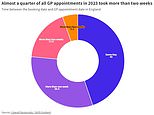More patients than ever before are having to wait at least a month to see their GP, shock data reveals.
NHS statistics show 17.6million appointments that took place in England in 2023 were booked one month earlier — or one in every 20.
It marks a rise of over a third in the space of a year, illustrating the dire crisis which has seen disgruntled patients abandon NHS surgeries in favour of going private or visiting swamped A&E units instead.
Campaigners warn the delays, fuelled by a shortage of GPs, puts patients at risk of having a serious illness diagnosed late or missed entirely.
The Liberal Democrats today warned the NHS is on ‘its knees’, with patients left paying the price.
Across England there were 347.9million GP appointments held last year, a rise of six per cent on the 328.4m logged in 2022, according to its analysis.
The number of patients waiting longer than two weeks to be seen also rose.
Almost a fifth of appointments (17.5 per cent) were booked a fortnight in advance, a rise on the 15.2 per cent recorded in 2022.
Four-week waits accounted for 3.9 per cent of all appointments in 2022. This rose to 5.1 per cent in 2023.
The proportion of same-day appointments, meanwhile, fell on the previous year with 43.9 per cent reported in 2022, compared to 43 per cent in 2023.
Latest NHS monthly data shows there were 25.8m GP appointments in December.
Almost half took place on the same day (45.7 per cent), up slightly on the previous month.
More than a quarter (29 per cent) had to wait more than a week.
The data for England also found two thirds (66.6 per cent) of GP consultations were face to face.
Lib Dem leader Ed Davey said: ‘Patients across the country are in a desperate position.
‘It has become commonplace to struggle day after day to get a GP appointment, leaving people in pain and discomfort.
‘What this Conservative government has done to our NHS is nothing short of scandalous.
‘They have brought the health service to its knees and it is patients and their loved ones who are paying the price of this Conservative party neglect.
‘It should be a given that people can see their GP when they need to, not a struggle.
‘That is why the Liberal Democrats are calling for a legal right for all patients to see their GP within seven days and 24-hours if in urgent need.’
NHS England argued 2million more GP appointments are now being delivered every month compared to pre-pandemic.
Dr Amanda Doyle, NHS England National Director for Primary Care and Community Services, said: ‘The NHS published a plan last year to improve access to GP services, which includes upgrading telephone systems to make it easier for people to contact their general practice while more than 36,000 additional staff have joined GP teams since 2019 to deliver even more appointments.
‘This is incredible progress from hardworking teams across the country and we are determined to make it easier to access services around people’s busy lives, so if you are concerned about your health please come forward for care.’
Family doctors, who earn six-figure salaries, on average, have reported cramming in up to 90 appointments per day, in a situation compared to a conveyor belt.
The BMA recommends GPs should not deliver more than 25 appointments per day to ensure safe care.
Latest NHS statistics show there were just under 27,500 fully-qualified GPs working across England in December.
This is just under 2,000 fewer than the figure recorded in the same month in 2016.
This is despite the population growing by around 2million over the same period.
Many GPs are retiring in their 50s, moving abroad or going private because of rising demand, NHS paperwork and aggressive media coverage.
This has led to an appointment crisis in general practice, with patients being forced to endure the 8am scramble. Others are forced to complete an online e-consult to reach their practice.
GPs also say they overwhelmed due to the pressures of the rising and ageing population and a lack of government funding.
Ministers have also silently binned a promise to hire 6,000 more GPs, which was a major part of Boris Johnson‘s election-winning manifesto.










